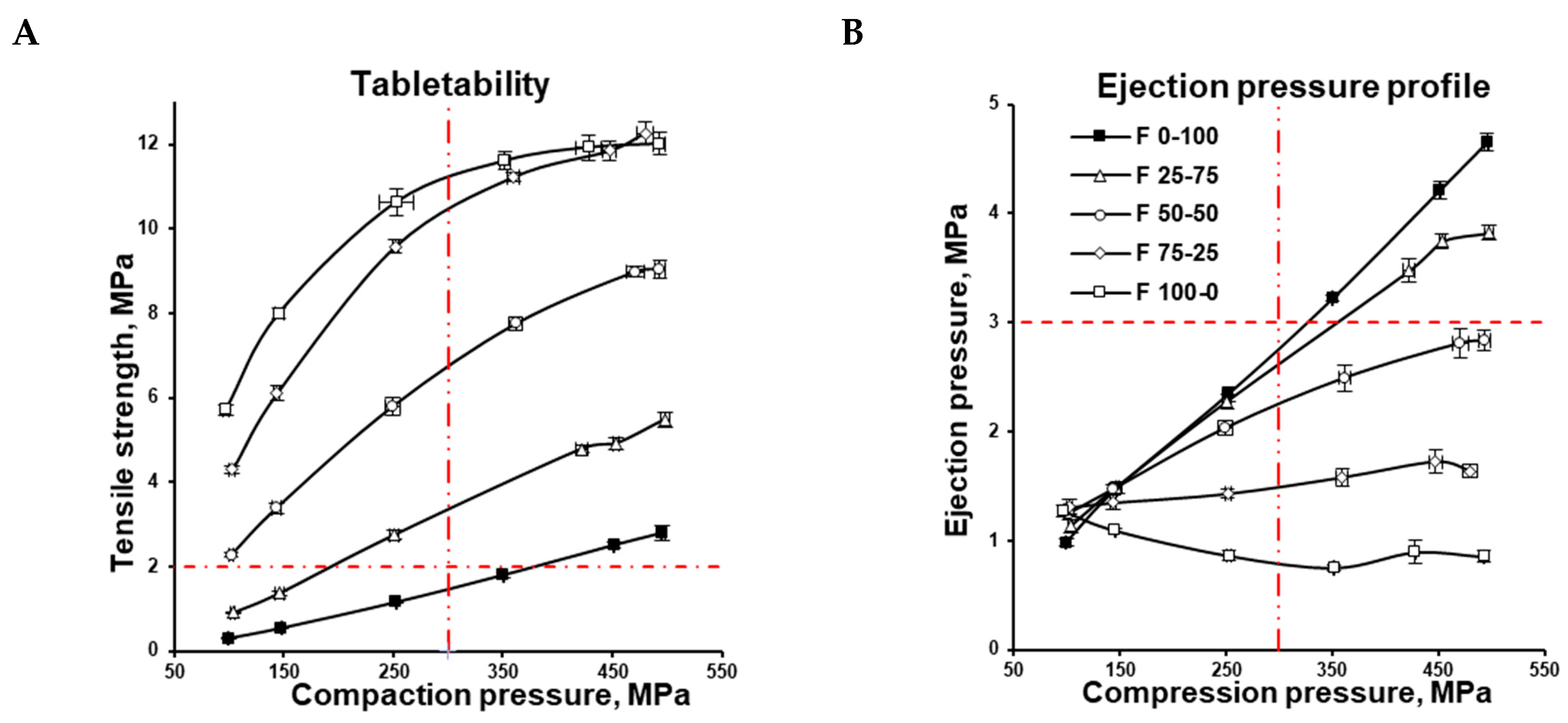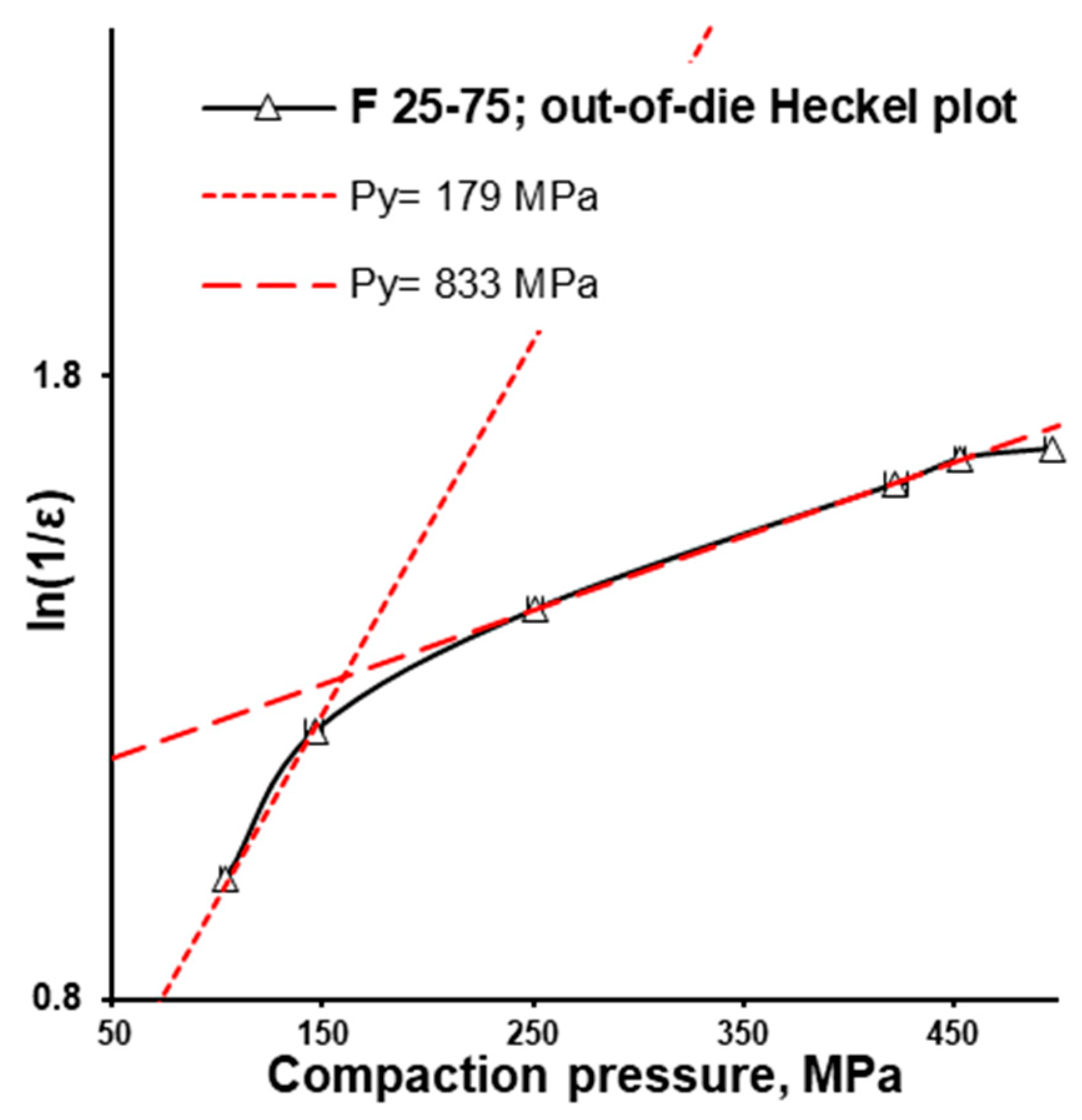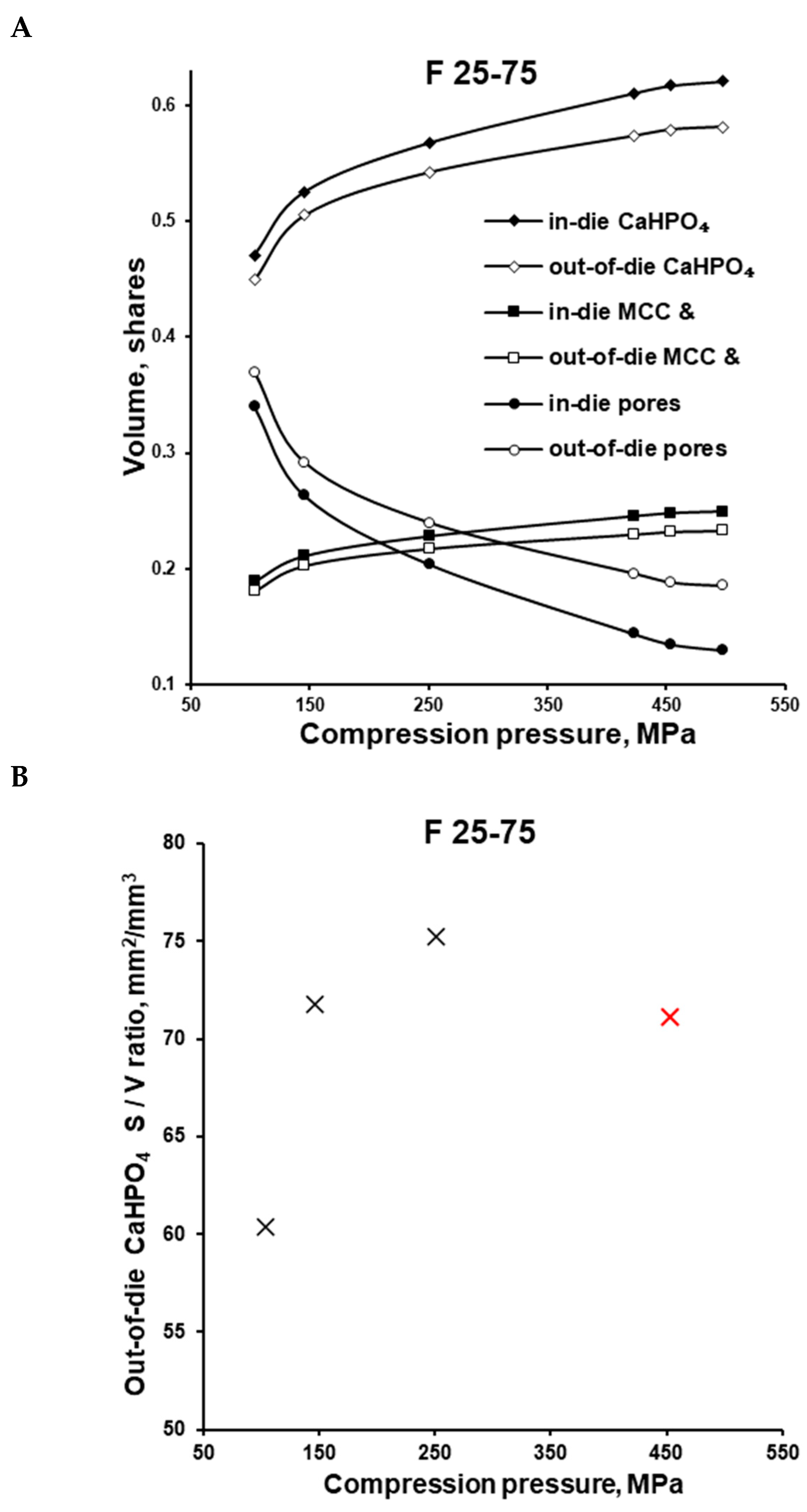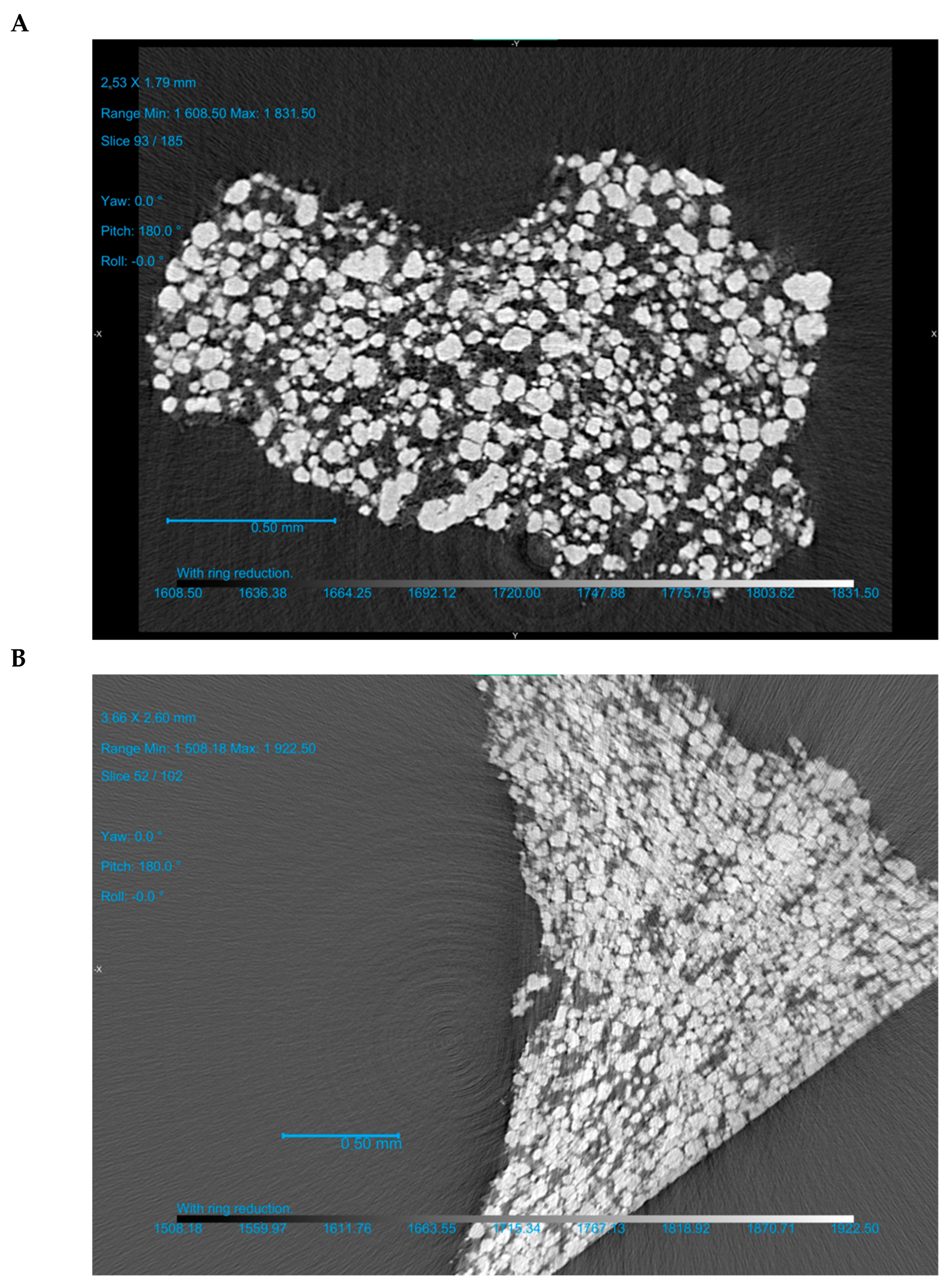The Effect of Microcrystalline Cellulose–CaHPO4 Mixtures in Different Volume Ratios on the Compaction and Structural–Mechanical Properties of Tablets
Abstract
1. Introduction
2. Materials and Methods
2.1. Materials
2.2. Microscopy
2.3. Preparation of Powder Mixtures
2.4. Preparation of Tablets
2.5. Tablet Hardness Measurement and Tensile Strength Calculation
2.6. Calculated True Density
2.7. Apparent Density, Porosity, and Solid Fraction Calculation
2.8. Heckel Plot Construction
2.9. Elastic Recovery
2.10. X-ray Micro-Computed Tomography (µCT) of Tablet Samples
3. Results and Discussion
4. Conclusions
Supplementary Materials
Author Contributions
Funding
Data Availability Statement
Acknowledgments
Conflicts of Interest
References
- Fell, J.T. Compaction Properties of Binary Mixtures. In Pharmaceutical Powder Compaction Technology; Alderborn, G., Nystrom, C., Eds.; Marcel Dekker, Inc.: New York, NY, USA, 1996; pp. 501–515. [Google Scholar]
- Vromans, H.; Lerk, C.F. Densification properties and compactibility of mixtures of pharmaceutical excipients with and without magnesium stearate. Int. J. Pharm. 1988, 46, 183–192. [Google Scholar] [CrossRef]
- Al-Ibraheemi, Z.A.M.; Anuar, M.S.; Taip, F.S.; Amin, M.C.I.; Tahir, S.M.; Mahdi, A.B. Deformation and Mechanical Characteristics of Compacted Binary Mixtures of Plastic (Microcrystalline Cellulose), Elastic (Sodium Starch Glycolate), and Brittle (Lactose Monohydrate) Pharmaceutical Excipients. Part. Sci. Technol. 2013, 31, 561–567. [Google Scholar] [CrossRef]
- Zakowiecki, D.; Edinger, P.; Papaioannou, M.; Hess, T.; Kubiak, B.; Terlecka, A. Exploiting synergistic effects of brittle and plastic excipients in directly compressible formulations of sitagliptin phosphate and sitagliptin hydrochloride. Pharm. Dev. Technol. 2022, 27, 702–713. [Google Scholar] [CrossRef]
- Garr, J.S.M.; Rubinstein, M.H. The effect of rate of force application on the properties of microcrystalline cellulose and dibasic calcium phosphate mixtures. Int. J. Pharm. 1991, 73, 75–80. [Google Scholar] [CrossRef]
- Moreton, R.C. Calcium Phosphate Dibasic Anhydrous. In Handbook of Pharmaceutical Excipients, 5th ed.; Rowe, R.C., Sheskey, P.J., Owen, S.C., Eds.; Pharmaceutical Press and American Pharmacists Association: London, UK; Grayslake, IL, USA, 2006. [Google Scholar]
- Galichet, L.Y. Cellulose Microcrystalline. In Handbook of Pharmaceutical Excipients, 5th ed.; Rowe, R.C., Sheskey, P.J., Owen, S.C., Eds.; Pharmaceutical Press and American Pharmacists Association: London, UK; Grayslake, IL, USA, 2006. [Google Scholar]
- Zhao, H.; Shi, C.; Zhao, L.; Wang, Y.; Shen, L. Influences of different microcrystalline cellulose (MCC) grades on tablet quality and compression behavior of MCC-lactose binary mixtures. J. Drug Deliv. Sci. Technol. 2022, 77, 103893. [Google Scholar] [CrossRef]
- Haware, R.V.; Bauer-Brandl, A.; Tho, I. Comparative evaluation of the powder and compression properties of various grades and brands of microcrystalline cellulose by multivariate methods. Pharm. Dev. Technol. 2010, 15, 394–404. [Google Scholar] [CrossRef]
- Zhao, H.; Zhao, L.; Lin, X.; Shen, L. An update on microcrystalline cellulose in direct compression: Functionality, critical material attributes, and co-processed excipients. Carbohydr. Polym. 2022, 278, 118968. [Google Scholar] [CrossRef]
- Schmidt, P.C.; Herzog, R. Calcium phosphates in pharmaceutical tableting. 2. Comparison of tableting properties. Pharm. World Sci. 1993, 15, 116–122. [Google Scholar] [CrossRef]
- Ekmekciyan, N.; Tuglu, T.; El-Saleh, F.; Muehlenfeld, C.; Stoyanov, E.; Quodbach, J. Competing for water: A new approach to understand disintegrant performance. Int. J. Pharm. 2018, 548, 491–499. [Google Scholar] [CrossRef]
- Johansson, B.; Alderborn, G. The effect of shape and porosity on the compression behaviour and tablet forming ability of granular materials formed from microcrystalline cellulose. Eur. J. Pharm. Biopharm. 2001, 52, 347–357. [Google Scholar] [CrossRef]
- Sun, C.C. Decoding Powder Tabletability: Roles of Particle Adhesion and Plasticity. J. Adhes. Sci. Technol. 2012, 25, 483–499. [Google Scholar] [CrossRef]
- Thoorens, G.; Krier, F.; Rozet, E.; Carlin, B.; Evrard, B. Understanding the impact of microcrystalline cellulose physicochemical properties on tabletability. Int. J. Pharm. 2015, 490, 47–54. [Google Scholar] [CrossRef] [PubMed]
- Skelbaek-Pedersen, A.L.; Al-Sharabi, M.; Vilhelmsen, T.K.; Rantanen, J.; Zeitler, J.A. Effect of particle size and deformation behaviour on water ingress into tablets. Int. J. Pharm. 2020, 587, 119645. [Google Scholar] [CrossRef] [PubMed]
- Wagner, M.; Hess, T.; Zakowiecki, D. Studies on the pH-Dependent Solubility of Various Grades of Calcium Phosphate-based Pharmaceutical Excipients. J. Pharm. Sci. 2022, 111, 1749–1760. [Google Scholar] [CrossRef] [PubMed]
- Arnold-Lockwood, E.; Sproston, K.E.; Kraus, D.; Brady, A.S. The Impact of Formulation on Dissolution Coning: Supporting Development of a Classification System and Predictive Tool. Br. J. Pharm. 2023, 8, 1348. [Google Scholar] [CrossRef]
- Holman, L.E. The compressibility of pharmaceutical particulate systems. An illustration of percolation. Int. J. Pharm. 1991, 71, 81–94. [Google Scholar] [CrossRef]
- Schmidt, P. Compression force/time-profiles of microcrystalline cellulose, dicalcium phosphate dihydrate and their binary mixtures—A critical consideration of experimental parameters. Eur. J. Pharm. Biopharm. 1997, 44, 303–313. [Google Scholar] [CrossRef]
- Bourland, M.E.; Mullarney, M.P. Compaction Simulation. In Pharmaceutical Dosage Forms: Tablets—Unit Operations and Mechanical Properties, 3rd ed.; Augsburger, L.L., Hoag, S.W., Eds.; Informa Healthcare USA, Inc.: New York, NY, USA, 2008; Volume 1. [Google Scholar]
- STYL’One Nano the Most Advanced Benchtop Tablet Press; Medelpharm SAS: Lyon, France, 2019; Available online: https://www.pharmaceutical-networking.com/wp-content/uploads/2020/11/The-most-advanced-Benchtop-Tablet-Press-STYLOne-Nano.pdf (accessed on 26 February 2024).
- Fell, J.T.; Newton, J.M. Determination of tablet strength by the diametral-compression test. J. Pharm. Sci. 1970, 59, 688–691. [Google Scholar] [CrossRef]
- Elsergany, R.N.; Vreeman, G.; Sun, C.C. An approach for predicting the true density of powders based on in-die compression data. Int. J. Pharm. 2023, 637, 122875. [Google Scholar] [CrossRef]
- Weller, P.J. Sodium Stearyl Fumarate. In Handbook of Pharmaceutical Excipients, 5th ed.; Rowe, R.C., Sheskey, P.J., Owen, S.C., Eds.; Pharmaceutical Press and American Pharmacists Association: London, UK; Grayslake, IL, USA, 2006. [Google Scholar]
- Owen, S.C. Colloidal Silicon Dioxide. In Handbook of Pharmaceutical Excipients; Rowe, R.C., Sheskey, P.J., Owen, S.C., Eds.; Pharmaceutical Press and American Pharmacists Association: London, UK; Grayslake, IL, USA, 2006. [Google Scholar]
- Mohylyuk, V.; Bandere, D. High-Speed Tableting of High Drug-Loaded Tablets Prepared from Fluid-Bed Granulated Isoniazid. Pharmaceutics 2023, 15, 1236. [Google Scholar] [CrossRef]
- Tye, C.K.; Sun, C.C.; Amidon, G.E. Evaluation of the effects of tableting speed on the relationships between compaction pressure, tablet tensile strength, and tablet solid fraction. J. Pharm. Sci. 2005, 94, 465–472. [Google Scholar] [CrossRef]
- User Guide and Reference Manual of Software Alix (PR-W3-002); Medelpharm SAS: Lyon, France, 2020.
- Heckel, R.W. Density-pressure relationships in powder compaction. Trans. Metall. Soc. AIME 1961, 221, 671–675. [Google Scholar]
- Fell, J.T.; Newton, J.M. Effect of particle size and speed of compaction on density changes in tablets of crystalline and spray-dried lactose. J. Pharm. Sci. 1971, 60, 1866–1869. [Google Scholar] [CrossRef] [PubMed]
- Boudina, I.; Rondet, E.; Nezamabadi, S.; Sharkawi, T. Insight into tableted pellets by combining X-ray micro-computed tomography and experimental compaction. Powder Technol. 2022, 397, 117083. [Google Scholar] [CrossRef]
- Polak, P.; Sinka, I.C.; Reynolds, G.K.; Roberts, R.J. Successful Formulation Window for the design of pharmaceutical tablets with required mechanical properties. Int. J. Pharm. 2024, 650, 123705. [Google Scholar] [CrossRef] [PubMed]
- Nystrom, C.; Karehill, P.-G. The Importance of Intermolecular Bonding Forces and the Concept of Bonding Surface Area. In Pharmaceutical Powder Compaction Technology; Alderborn, G., Nystrom, C., Eds.; Marcel Dekker, Inc.: New York, NY, USA, 1996; Volume 71, pp. 17–53. [Google Scholar]
- Bolhuis, G.K.; Lerk, C.F.; Zijlstra, H.T.; De Boer, A.H. Film formation by magnesium stearate during mixing and its effect on tableting. Pharm. Weekbl. 1975, 110, 317–325. [Google Scholar]
- Gunawardana, C.A.; Kong, A.; Blackwood, D.O.; Travis Powell, C.; Krzyzaniak, J.F.; Thomas, M.; Calvin Sun, C. Magnesium Stearate Surface Coverage on Tablets and Drug Crystals: Insights from SEM-EDS Elemental Mapping. Int. J. Pharm. 2022, 630, 122422. [Google Scholar] [CrossRef]
- Fuhler, C. Interparticulate Attraction Mechanisms. In Pharmaceutical Powder Compaction Technology; Alderborn, G., Nystrom, C., Eds.; Marcel Dekker, Inc.: New York, NY, USA, 1996; pp. 1–15. [Google Scholar]
- Vreeman, G.; Sun, C.C. Mean yield pressure from the in-die Heckel analysis is a reliable plasticity parameter. Int. J. Pharm. X 2021, 3, 100094. [Google Scholar] [CrossRef]







| Ingredients | True Density | F 100-0 | F 75-25 | F 50-50 | F 25-75 | F 0-100 | F 100-0 | F 75-25 | F 50-50 | F 25-75 | F 0-100 |
|---|---|---|---|---|---|---|---|---|---|---|---|
| mg/mm3 | w/w | Volume, % | |||||||||
| CEOLUS TM UF-711 | 1.586 | 0.977 | 0.608 | 0.346 | 0.151 | 0.000 | 96.9 | 72.3 | 47.9 | 23.8 | 0.0 |
| DI-CAFOS® A60 | 2.890 | 0.000 | 0.369 | 0.631 | 0.826 | 0.977 | 0.0 | 24.1 | 47.9 | 71.4 | 94.6 |
| PRUV® | 1.110 | 0.020 | 0.020 | 0.020 | 0.020 | 0.020 | 2.8 | 3.4 | 4.0 | 4.5 | 5.0 |
| SYLOID® 244FP | 2.200 | 0.003 | 0.003 | 0.003 | 0.003 | 0.003 | 0.2 | 0.3 | 0.3 | 0.3 | 0.4 |
| ∑ | – | 1.000 | 1.000 | 1.000 | 1.000 | 1.000 | 100.0 | 100.0 | 100.0 | 100.0 | 100.0 |
| Calculated true density | – | 1.578 | 2.060 | 2.401 | 2.655 | 2.852 | |||||
| Compression Pressure (MPa) | |||||||
|---|---|---|---|---|---|---|---|
| Volume Shares of | 104 | 146 | 251 | 423 | 454 | 498 | |
| in-die | CaHPO₄ | 0.471 | 0.526 | 0.568 | 0.611 | 0.617 | 0.621 |
| MCC and the other excipients | 0.189 | 0.211 | 0.228 | 0.245 | 0.248 | 0.249 | |
| porosity | 0.340 | 0.264 | 0.204 | 0.144 | 0.135 | 0.130 | |
| ∑ | 1.000 | 1.000 | 1.000 | 1.000 | 1.000 | 1.000 | |
| out-of-die | CaHPO₄ | 0.450 | 0.505 | 0.542 | 0.574 | 0.579 | 0.581 |
| MCC and the other excipients | 0.180 | 0.203 | 0.218 | 0.230 | 0.232 | 0.233 | |
| porosity | 0.370 | 0.292 | 0.240 | 0.196 | 0.188 | 0.185 | |
| ∑ | 1.000 | 1.000 | 1.000 | 1.000 | 1.000 | 1.000 | |
Disclaimer/Publisher’s Note: The statements, opinions and data contained in all publications are solely those of the individual author(s) and contributor(s) and not of MDPI and/or the editor(s). MDPI and/or the editor(s) disclaim responsibility for any injury to people or property resulting from any ideas, methods, instructions or products referred to in the content. |
© 2024 by the authors. Licensee MDPI, Basel, Switzerland. This article is an open access article distributed under the terms and conditions of the Creative Commons Attribution (CC BY) license (https://creativecommons.org/licenses/by/4.0/).
Share and Cite
Mohylyuk, V.; Paulausks, A.; Radzins, O.; Lauberte, L. The Effect of Microcrystalline Cellulose–CaHPO4 Mixtures in Different Volume Ratios on the Compaction and Structural–Mechanical Properties of Tablets. Pharmaceutics 2024, 16, 362. https://doi.org/10.3390/pharmaceutics16030362
Mohylyuk V, Paulausks A, Radzins O, Lauberte L. The Effect of Microcrystalline Cellulose–CaHPO4 Mixtures in Different Volume Ratios on the Compaction and Structural–Mechanical Properties of Tablets. Pharmaceutics. 2024; 16(3):362. https://doi.org/10.3390/pharmaceutics16030362
Chicago/Turabian StyleMohylyuk, Valentyn, Artūrs Paulausks, Oskars Radzins, and Liga Lauberte. 2024. "The Effect of Microcrystalline Cellulose–CaHPO4 Mixtures in Different Volume Ratios on the Compaction and Structural–Mechanical Properties of Tablets" Pharmaceutics 16, no. 3: 362. https://doi.org/10.3390/pharmaceutics16030362
APA StyleMohylyuk, V., Paulausks, A., Radzins, O., & Lauberte, L. (2024). The Effect of Microcrystalline Cellulose–CaHPO4 Mixtures in Different Volume Ratios on the Compaction and Structural–Mechanical Properties of Tablets. Pharmaceutics, 16(3), 362. https://doi.org/10.3390/pharmaceutics16030362







